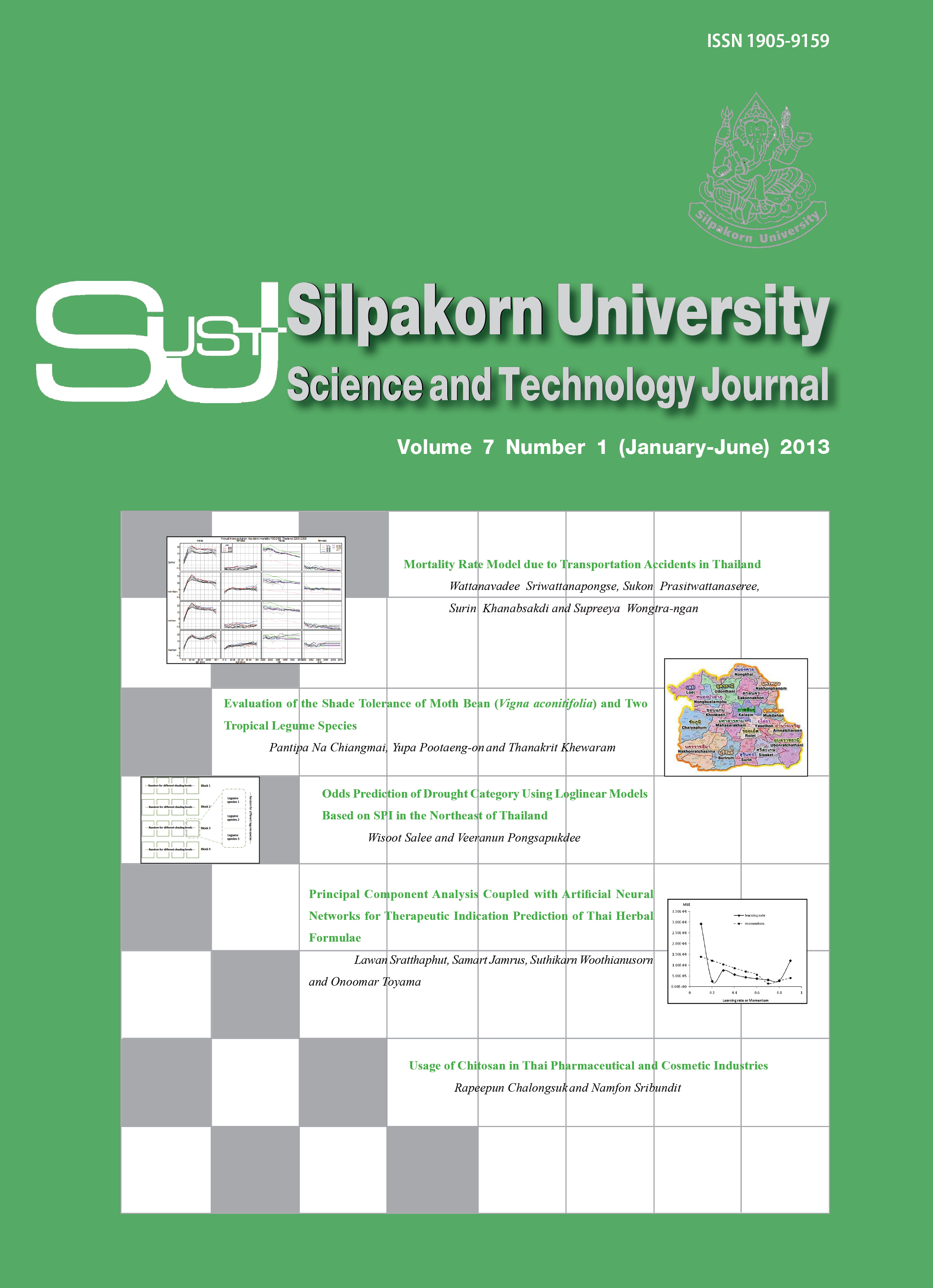Evaluation of the Shade Tolerance of Moth Bean (Vigna aconitifolia) and Two Tropical Legume Species
Main Article Content
Abstract
This study aimed to evaluate the shading tolerance ability in moth bean (Vigna aconitifolia) in two experiments. In experiment 1, moth bean, Centrosema pascuorum cv. Cavalcade and Stylosanthes guianensis cv. Tha pra (Tha pra stylo) were grown under different sunlight shading levels by covering these plots with a black net. In Experiment 2, moth bean was intercropped with sunflower (Helianthus annuus) synthetic variety (Suranaree (S) 471). Both experiments were conducted in a field trial from May to August in 2011 at Agricultural Practice Farm of Faculty of Animal Science and Agricultural Technology, Silpakorn University, Phetchaburi Information Technology Campus, Phetchaburi, Thailand.
In Experiment 1, the results showed that shading reduced almost all plant growth characteristics, except plant height. All of legume species had possessed different tolerant capacity to shading, but these plants were dead at 90% of the shading level.
In Experiment 2, the agronomic traits of sunflower were not affected by intercropping with moth bean. Fresh and dry weight per plant of moth bean intercropping with sunflower was decreased, comparing with those of a moth bean monoculture. However, there was no significant difference in crude protein content of moth bean between monoculture and intercropping with sunflower.
Downloads
Article Details
References
Basak, M. N., Sen, S. K., and Bhattacharjee, P. K. (1962). Effects of high nitrogen fertilization and lodging on rice yields. Agronomy Journal, 54: 477-480.
Canham, C. D, Denslow, J. S, Platt, W. J., Runkle, J. R., Spies, T. A., and White, P. S. (1990). Light regimes beneath closed canopies and tree-fall gaps in temperate and tropical forests. Canadian Journal of Forest Research, 20(5): 620-631.
Casper, B. B. and Jackson, R. B. (1997). Plant competition underground. Annual Review of Ecology and Systematics, 28: 545-570.
Chujaroen, S., Kongcharoen, A., and Na Chiangmai, P. (2006). Characterization of yield and yield components in Vigna spp. Kamphaengsaen Academic Journal, 4: 733-739.
Clements, F. E., Weaver, J. E., and Hanson, H. C. (1929). Plant competition analysis of community functions, Carnegie Institution of Washington publication.
Day, A. D. (1957). Effect of loding on yield, test weight and other seed characteristics of spring barley grown under flood irrigation as a winter annual. Agronomy Journal, 49: 536-539.
Ephrath, J. E., Wang, R. F., Terashima, K., Hesketh, J. D., Huck, M. G., and Hummel, J. W. (1993). Shading effects on soybean and corn. Biotronics, 22: 15-24.
Grubb, P. J. (1998). A reassessment of the strategies of plants which cope with shortages of resources. Perspectives in Plant Ecology, Evolution and Systematics, 1: 3-31.
Henry, H. A. and Thomas, S. C. (2002). Interactive effects of lateral shade and wind on stem allometry, biomass allocation, and mechnical stability in Abutilon Theophrasti (Malvaceae). American Journal of Botany, 89(10): 1609-1615.
Kharb, R. P. S., Singh, V. P., and Tomar, Y. S. (1987). Moth bean (Vigna aconitifolia Jacq. (Mareehal)). A review Forage Research Journal.
Kongcharoen, A., Chujaroen, S., Nilprapruck, P., Pummarin, P., and Na Chiangmai, P. (2006). Comparison of nutritional values in various species of Vigna spp. Kampaengsaen Academic Journal, 4: 740-746.
Larson, J. C. and Maranville, J. W. (1977). Alternations of yield, test weight, and protein in lodged grain sorghum. Agronomy Journal, 69: 629-630.
Liu, B., Liu, X. B., Wang, C., Li, Y. S., Jin, J., and Herbert, S. J. (2010). Soybean yield and yield component distribution across the main axis in response to light enrichment and shading under different densities. Plant Soil Environmen, 56(8): 384-392.
Na Chiangmai, P., Nanongtoom, S., and Arunkeereewat, S. (2009a). The effect of drought manipulation on seed yield and seed yield component characters in Vigna spp. and Centrosema pascuorum cv. Cavalcade in the field. In Proceedings: Second International Conference on Suctainable Animal Agriculture for Developing Countries (SAADC 2009), Kuala Lumpur, Malaysis.
Na Chiangmai, P., Chansem, T., and Bootnoi, S. (2009b). Drought manipulation: Effects on nutritive values of legume species; Vigna spp., Centrosema pascuorum cv. Cavalcade and Stylosanthes guianensis cv. Tha pra. In Proceedings: Second Interactional Conference on Suctainable Animal Agriculture for Developing Countries (SAADC 2009), Kuala Lumpur, Malaysis.
Nagashima, H., Terashima, I., and Katoh, S. (1995). Effects of plant density on frequency distributions of plant height in Chenopodium album stands: analysis based on continuous monitoring of height growth of individual plants. Annals of Botany, 75: 173-180.
Niklas, K. J. (1998). The influence of gravity and wind on land plant evolution. Review of Paleobotany and Palynology, 102: 1-14.
Phengsavanh, P. and Inger, L. (2003). Effect of Stylo 184 (Stylosanthes guianensis CIAT 184) and Gamba grass (Andropogon gayanus cv. Kent) in diets for growing goats; Livestock Research for Rural Development 15(10). [Online URL: www.lrrd.org/lrrd15/10/seut1510.htm]. Accessed on September 27, 2012.
Porter, A. M. (1937). Effect of light intersity on the photosynthetic efficiency of tomato plants. Plant Physiology, 12(2): 225-252.
Schmitt, J., Dudley, S. A., and Pigliucci, M. (1999). Manipulative approaches to testing adaptive plasticity: phytochrome-mediated shade-avoidance responses in plants. American Naturalist 154 (suppl.): S43-S54.
Setter, T. L., Laureles, E. V., and Mazaredo, A. M. (1997). Lodging reduces yield of rice by self-shading and reductions in canopy photosynthesis. Field Crops Research, 49: 95-106.
Smith, H. (1982). Light quality, photoreception, and plant strategy. Annual Review of Plant Physiology, 33: 481-518.
Sparkes, D. L., Berry, P., and King, M. (2008). Effects of shade on root characters associated with lodging in wheat (Triticum aestivum). The Annuals of Applied Biology, 158(3): 389-395.
Valladares, F. (2003). Light heterogeneity and plants: from ecophysiology to species coexistence and biodiversity. In Progress in Botany (Esser, K., Luttge, U., Beyschlag, W., and Hellwig, F., eds.), pp. 439-471. Springer-Verlag, Heidelberg.
Valladares, F. and Ülo Niinemets. (2008). Shade tolerance, a key plant feature of complex nature and consequences. Annual Review of Ecology, Evolution, and Systematics, 39: 237-257.
Weiner, J., Berntson, G. M., and Thomas, S. C. (1990). Competition and growth form in a woodland annual. Journal of Ecology, 78: 459-469.
Went, F. W. (1973). Competition Among Plants. In Proceedings of the National Academy of Science of the United States of America, 70(2): 585-590.

